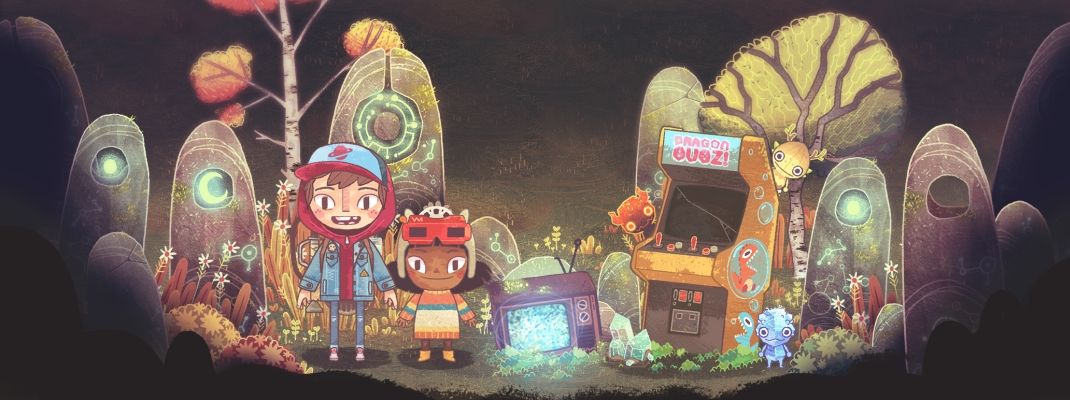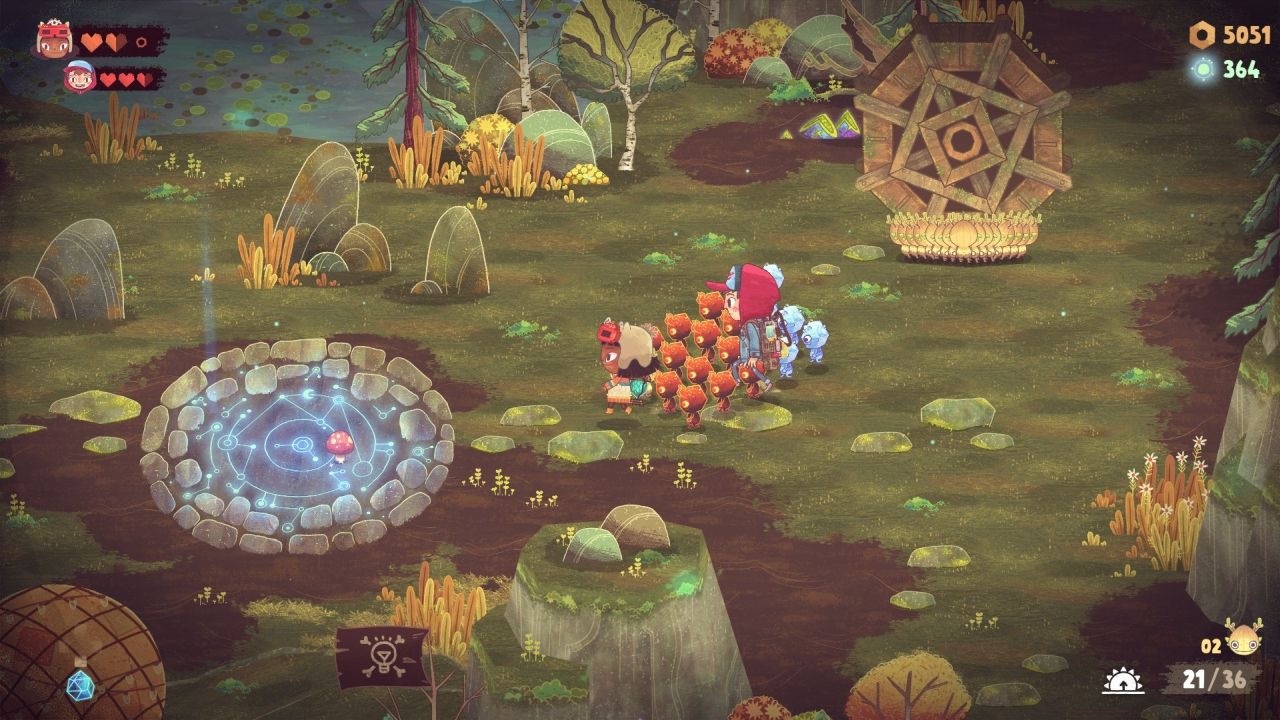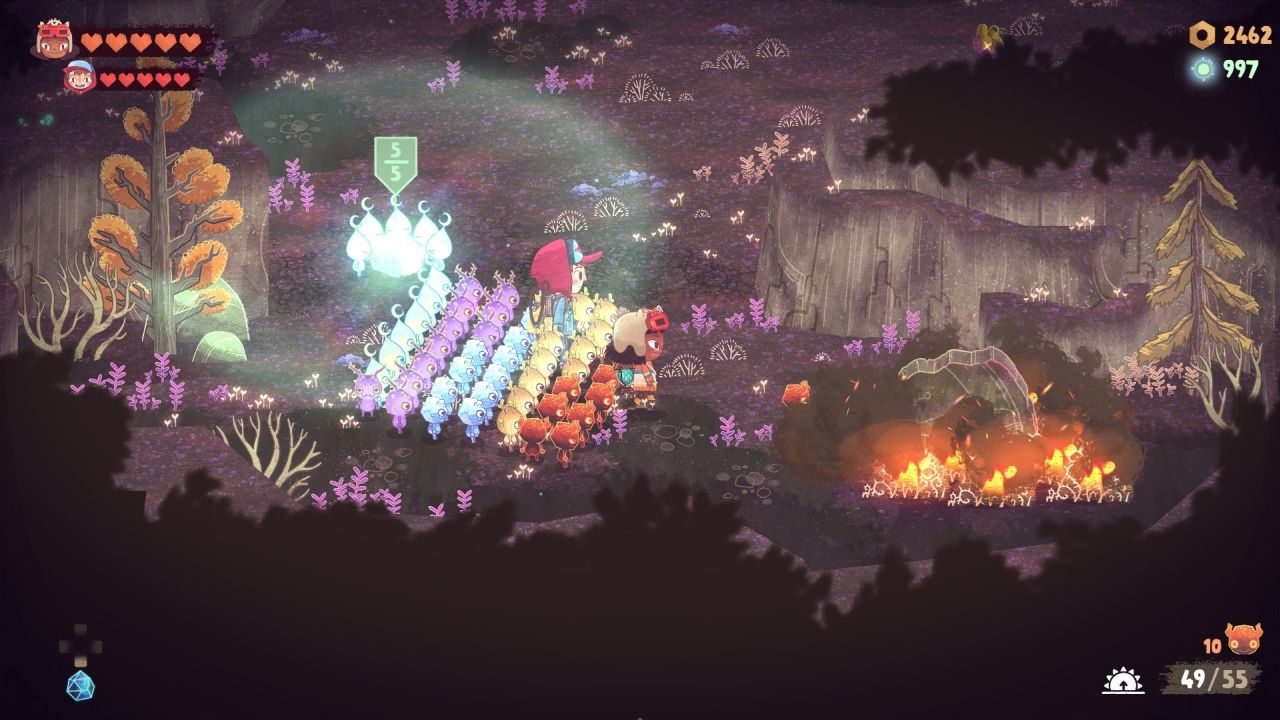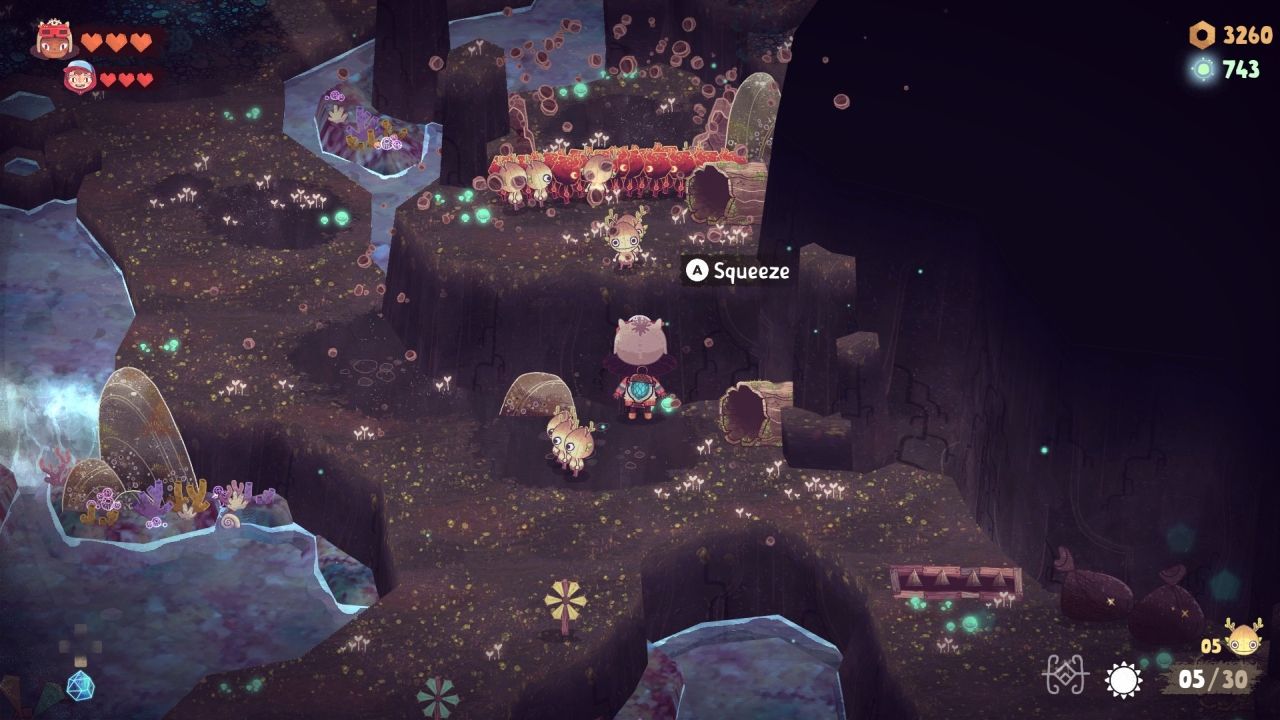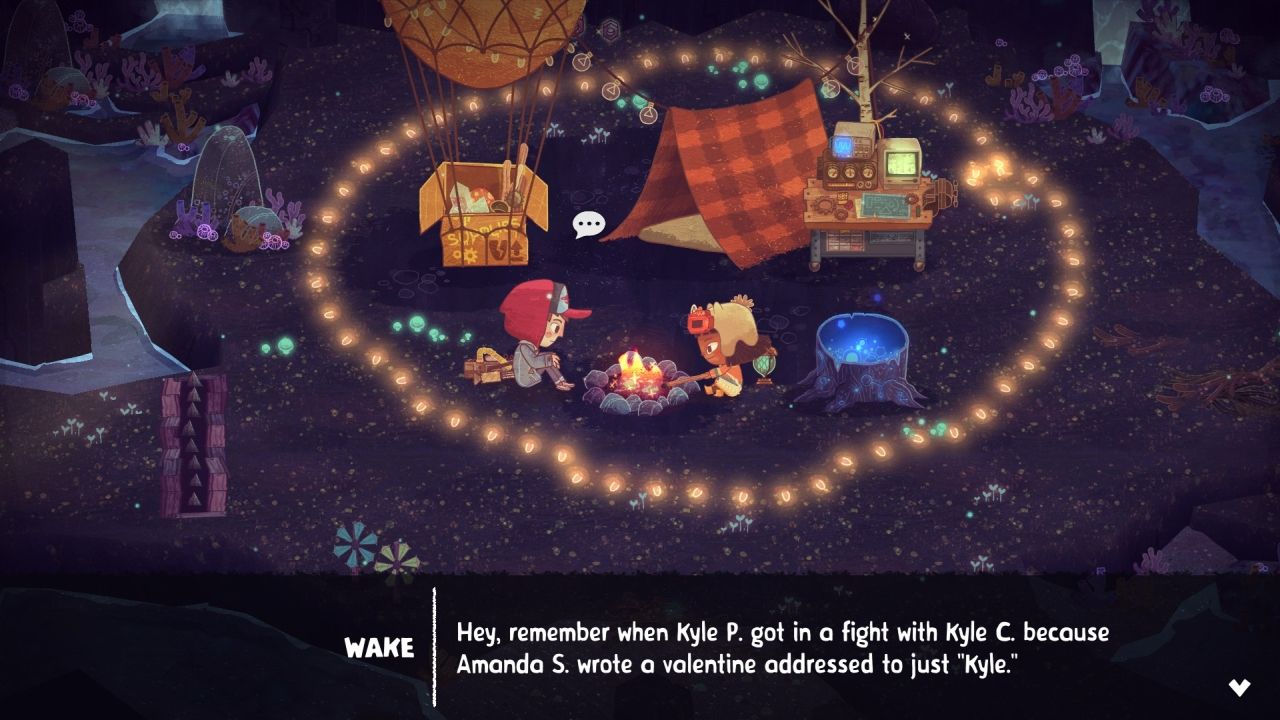We do like to talk about how classic childhood adventures are dark and traumatic, don't we? Labyrinth, The Neverending Story, The Witches, Cloak and Dagger (if you want an example of one such adventure that was deliberately dark)...the list goes on. Maybe we love to bring them up because their darkness makes them more interesting and deep, that they were mature and weren't afraid to pull punches with their stories, contrasting with the more light-hearted action they showcase. Regardless, generations grew up on these films and so we now have a ton of tales that evoke such adventures. Today's example of such modern tales is The Wild at Heart, a Pikmin-esque fantasy action-adventure game from developers Moonlight Kids. It's an intriguing adventure with a colorful coating and a darker core with its own unique world, but is it also one for the ages or just a flop?
The Wild at Heart follows a pair of kids known as Wake and Kirby, who are preparing to run away from home and head out into the woods, channeling that classic fantasy many of us have had as youngsters. Soon, they find themselves in a world known as the Deep Woods, home to the Greenshields, offbeat citizens such as a quirky collector of junk with a tea kettle on his head, a crazy cat lady, a man who only communicates with paper planes, and several adorable little creatures known as the Spritelings...oh, and a dark malevolent force known as the Never that threatens to erase the memories of everyone in the Deep Woods and eventually free itself even further, consuming everything. Because of course there's one of those.
So Wake and Kirby eventually head out in search of three mystical artifacts in order to help the Greenshields. Luckily, the Spritelings are more than willing to help them. These little critters can be flung at enemies to attack them, can smash known barriers, carry objects both big and small, and more. You can discover more types of them as you progress, each with their own immunity, skills and specific obstacles that they can destroy. In a way, it's the classic metroidvania formula of picking up new skills that allow you to access and explore new places. And exploration is the name of the game, as you set out across several stunning bits of nature...but beware, for if you stay out when night falls, the Never's minions will stalk you, hunt you, kill your Spritelings and deal serious damage to you...or don't beware, because after a tense introduction in the beginning, I never encountered these enemies again for a good seven hours or so.
Getting straight to the point, while I liked The Wild at Heart overall, it seemed to suffer from what feels like either over-ambition, an overabundance of mechanics, a constant need to try and balance all aspects of possible difficulty out, something else or all of the above. Whatever the case, there are way too many parts of it that felt pointless for various reasons. Case in point, the creatures that attack you at night. It sounds intimidating at first, making you fear the idea of venturing out too far, but because the levels aren't that big, it's easy to just get back to one of your camps once sunset begins and the ominous music plays, sleep until the next morning, then immediately pick up where you left off. The only reason I even saw them again during the previously-mentioned encounter is because of a huge rock which needed to be moved that basically said "Hey, are you willing to grind your until you can have seventy Spritelings follow you? If not, just show up at night with some of the Lunalings in tow instead, because they're stronger when it's night and can lift this thing quicker. Seriously, please, we need to justify this feature."
The only other reason to stay out at night that I could find are a few treasure chests that are only accessible then, but I decided they weren't worth it, even if they did contain an ingredient needed for upgrades. Actually, most of The Wild at Heart's side content arguably isn't worth it. There are some large items you need to grab with the Spritelings in order to gain access to shops, upgrades, and more, but purchasing items afterwards is astonishingly easy. The game uses two types of currencies (one for purchasing items, and one for creating new Spritelings and increasing the amount that follow you), but items containing them are plentiful and respawn on a regular basis. Heck, most of them are even right next to your camps or nearby fast travel points. And the only reason to do side quests like bounty hunts or finding lost cats is to earn more currency, and the amount gained is basically what you can earn by traveling around for about fifteen minutes or so.
Even Spritelings dying in the field isn't a that big an issue, since the plants containing the seeds that grow them are nearby as well. And as a lot of combat basically becomes "just chuck a ton of Spritelings at an enemy and stay back" over time (chucking the right ones in some cases, though), Wake and Kirby's health is never an issue either, especially since their health fully refills after sleeping at camp. Heck, while I healed couple of times during the first couple of hours, I quickly found myself never needing to heal again until the final boss fight (which ended up being easy)! This also means that, save for one or two mandatory points, crafting items to help in combat and other areas also feels unnecessary, leaving a ton of debris in the field.
Again, The Wild at Heart just seems to have way too many elements that weren't needed or could have been fine-tuned or dialed back. Come to think of it, it could have benefited from having the combat as a whole dialed back (only a few mandatory battles are used anyway, mainly to open gates). Because underneath the layers of superfluous content, there's still a good adventure game underneath it all. The level design is well done, with each area containing a splendid amount of nice and challenging environmental puzzles. Have Kirby head out into the muck that's safe for humans but fatal to Spritelings, crawl through a log to each an area above, have Wake fling Spritelings into a little bubble geyser so they rise to a point where Wake can vacuum them in and use them to grab an object up there, that sort of thing.
It's simple stuff, but executed well with a decent amount of variety and plenty of "Ohhh, now I get it" moments. It ends up using the aforementioned metroidvania formula to great effect as well, with seemingly every area containing some new path or secret to unlock. And speaking of the previously-mentioned vacuum, Wake's Gustbuster and Kirby's lantern are a ton of fun to use, be it working a windmill to lower a gate or using at to grab faraway objects. The controls in general are nice as well, with throwing and ordering the Spritelings around being a breeze. Using the Spritelings in combat is, again, simple, but I'd be lying if I said it wasn't still satisfying at times.
And while the rewards from the side quests may be a letdown, the cast of characters comes off as quirky and lovable enough that you'll want to attempt at least a few for them. This is mainly true when it comes to finding "relics" for Scrap Heap, which are mostly mundane trash like old washing machines, disco balls, outhouses and more, but the descriptions of them which come from a society that has been drained of their memories are highly entertaining, providing a good insight into the world of The Wild at Heart. In fact, while the main story itself isn't that particularly deep or even as dark as you'd expect (albeit still well-told and perfectly fine), the world itself and its lore is still brimming with personality, thus encouraging you to check out every inch of it.
Of course, it helps that said world is gorgeous, mind you, in case that wasn't obvious. The adorable style, the fun designs, the vivid landscapes find with tons of detail...it's all nothing sort of astonishing and truly a joy to see in action, especially once you encounter the larger creatures and objects. The soundtrack also has wonderful ambient tunes as well, making for a particularly pleasant journey. It's one that also lasts for a relatively small yet meaty eight to ten hours, giving you quite a bit to work with, even with a handful of main objectives.
The Wild at Heart gets dragged down a tad by some other notable flaws as well, though. The Spriteling AI isn't always perfect, especially with tens of them following you, and it's easy to leave a couple stranded after throwing them at times; the maps can be vague and inconsistent when it comes to objectives, such as showing me locations of tablet pieces I needed for one mission but not showing me the ones for Golden Oysters needed for another; and battling groups of certain enemies can be a pain in the ass at times. I can't say these are dealbreakers, but at least they're more related to the more necessary content.
Closing Comments:
The Wild at Heart is a fun, whimsical and challenging little action adventure game, largely thanks to its nicely-crafted puzzles, but it could have been a better adventure if it wasn't trying to cram in so much. Clear your mind of the excessive mechanics, though, and it's still a cute and enjoyable ode to the likes of Pikmin that still might be worth your time. It's not as traumatizing a journey as the truly classic childhood adventures are, but its spectacular world and impressive graphics make it quite the charming adventure instead.

